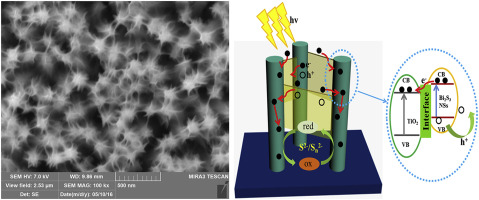Abstract: A novel 3D cross-linked heterostructure of TiO2 nanorods connecting with each other via ultrathin Bi2S3 nanosheets is constructed by a facile and effective strategy. The growth mechanism has been investigated and proposed based on the evolution of microstructure by changing the reaction parameters. Benefiting from the unique cross-linked heterostructure, the as-prepared Bi2S3 nanosheets modified TiO2 nanorods arrays could achieve a high energy conversion efficiency of 3.29% which is the highest value to date for Bi2S3-only sensitized solar cells as the reported highest value is 2.23% and other reported values are less than 1%. Furthermore, the photoelectrochemical studies clearly reveal that the novel cross-linked heterostructure exhibits much better activity than 0D nanoparticles decorated TiO2 nanorods under visible light irradiation, which may be primarily ascribed to the efficient electron transfer from 2D ultrathin Bi2S3 nanosheets to 1D TiO2 nanorod arrays. The promising results in this work confirm the advantages of cross-linked heterostructure and also undoubtedly offer an attractive synthesis strategy to fabricate other nanorod-based hierarchical architecture as well as nano-devices for solar energy conversion.

KeyWords Plus:SENSITIZED SOLAR-CELLS; TIO2 NANOTUBE ARRAYS; HYDROGEN GENERATION; WATER OXIDATION; ZNO NANOWIRES; CONTROLLED GROWTH; QUANTUM DOTS; NANOMATERIALS; ELECTROLYTE; NANOSHEETS
Published in JOURNAL OF POWER SOURCES, 329 23-30; 10.1016/j.jpowsour.2016.08.069 OCT 15 2016


